 Superconducting Quantum Interference Device Magnetometer
Superconducting Quantum Interference Device Magnetometer
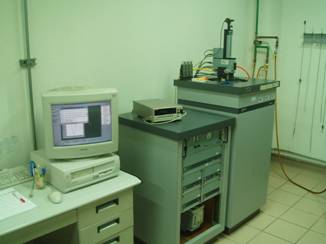
The superconducting quantum interference device magnetometer is a precision magnetic measuring system. A magnetic susceptibility measuring instrument that takes advantage of Josephson superconducting device and a combination of electron, cryogenic and vacuum technologies. The magnetometer consists of seven parts, including temperature controlled system, superconducting magnet system, SOUID detection system, sample moving system, gas processing system, liquid helium dewar bottle system, and computer automatic control system. The magnetic field range is ±5 Tesla and the temperature measurement range is 2K~300K. It can be used to analyze magnetic moment with different temperature and magnetic field.
 Physical Property Measurement System
Physical Property Measurement System
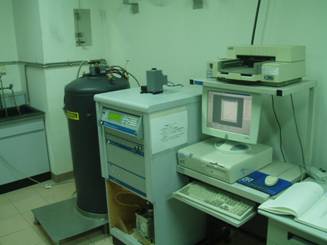
The physical property measurement system is a versatile working system, which can precisely control the temperature from 2K to 300K, and provides external fields up to ±9 Tesla. It can be used to do the electrical transport measurements with different field and temperature. This system can also expand different measurement options, including AC susceptibility signal measurement, specific heat measurement, and ultra-low magnetic field measurement.
 Molecular Beam Epitaxy
Molecular Beam Epitaxy
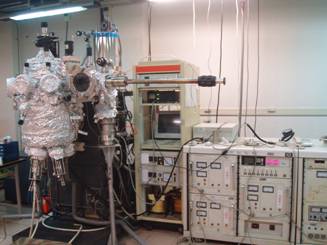
Ultra-high vacuum (UHV) system includs a turbomolecular pump and a cryo-pump. The vacuum degree can be up to 10-10 torr. By using an electron gun to epitaxially grow magnetic thin films and diluted magnetic semiconductor films, we can precisely control the thickness at the nanometer scale. The measuring instrument, Reflection-high Energy Electron Diffraction (RHEED), is also installed to analyze the crystal structure of the epitaxial films.
 Atomic Force Microscopy
Atomic Force Microscopy
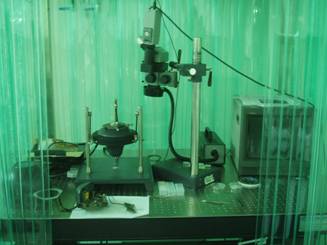
The tiny probe of an atomic force microscope (AFM) is usually attached to a cantilevered spring piece. When the tip of the probe is close to the surface of the sample, a force is generated by a force field, causing a slight deflection of the cantilever spring piece. The elastic deformation of spring can be sensed by optical detection method. The attractive force (van der waals force) between the tip atom and the atom on the surface of the sample makes the probe moved in the vertical direction and fine tune the distance between the tip and the sample. The distance information is stored as a two-dimensional function, which presents the surface topography of the sample. The force of the probe and the surface can be controlled in a very tiny amount with the range of 10-6 ~ 10-10 Newton. Therefore, the AFM can resolve the atomic size.
 Vacuum ion sputtering system
Vacuum ion sputtering system
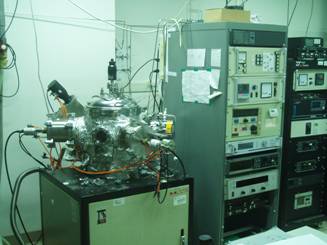
The instrument is called vacuum ion sputter, which makes the substrate coated by various substances of thickness in nanometers to micrometers (e.g. metal, alloy, silicon dioxide) without precise control of the material growth property and its thickness. The mechanism is that we use gas plasma to bombard the sputtering target and make the detached target molecules attached on the substrate trough the electromagnetic field. We can progress the ion sputtering and ion milling in the vacuum of 2×10-7 torr, vacuumed by the turbo pump.
 Sputtering System (2)
Sputtering System (2)
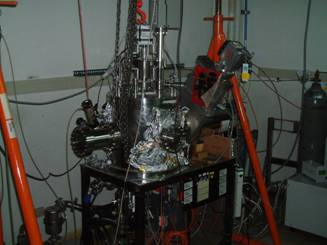
This is a high vacuum coating system, which is used to fabricate ferromagnetic superconducting films and study the influence of ferromagnetic layer deposited on the superconducting layer. In order to avoid contaminating the system environment, we use the cryopump as the succeeded pumping. Due to its operating temperature of 8K, the gas sucked by the activated carbon interlayer is condensed and sucked in the pump to achieve high vacuum. The argon (Ar) gas is introduced to form a plasma to bombard the target, and make the target particles deposited on the substrate to form a thin film.
 Sputtering System (3)
Sputtering System (3)
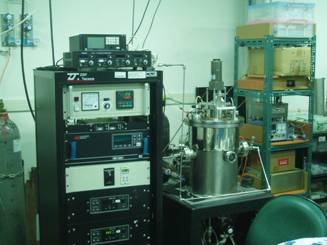
The experimental instrument is a vacuum sputtering machine. We will introduce argon (Ar) gas into a high vacuum environment to generate a plasma, bombarding sputtering target. The detached particles of the target are affected by the magnetic field and adsorbed on the substrate. The semiconductor target is mainly used. The mixed transition metal is used to make a diluted magnetic semiconductor films. There are three 2-inch sputtering guns in the system. With turbomolecular pump, ion sputtering can be performed with vacuum pressure lower than 10-7 torr.
 Small signal electrical measurement system
Small signal electrical measurement system

The normal electrical measurement is to analyze the electrical transport properties of the film with current in plane. If we want to study the transport properties of the electron in the interface between the metallic multilayers, it is necessary to make the current perpendicular to plane go through each layers. By doing this, we can separate the characteristics of the material itself (bulk) and the contribution of the interface. Since the resistance is tiny for the metallic film system (For example, with an circle-shape electrode of 3 mm in diameter, the resistance is less than 1 mΩ.), we need to develop a method to resolve such kind of tiny signal. In recent years, we have successfully established a small signal measurement system by using a superconducting quantum interference device magnetometer (SQUID) as an amplifying bridge. It is built in an environment without electromagnetic noise. The voltage resolution can reach 10-12 volts so that the tiny electrical signals can be resolved.
 Ultrathin system
Ultrathin system
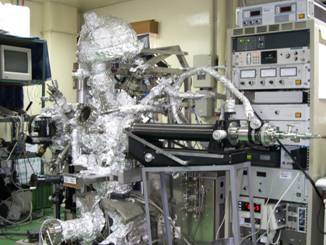
* AES ( Auger Electron Spectrometer) — Component
* LEED ( Low Energy Electron Diffraction)* RHEED ( Reflection High Energy Electron Diffraction) — Structure
* SMOKE ( Surface Magneto-Optic Kerr Effect ) — Magnetic properties
 Magneto-optical Kerr Effect
Magneto-optical Kerr Effect
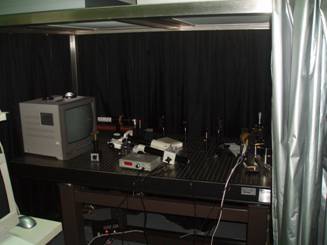
Magneto-optical Kerr Effect is the phenomenon of a linearly-polarized light reflected by magnetic material and then changed into elliptically-polarized light. The mechanism is as follows. We can regard the linearly-polarized light as a combination of left-handed and right-handed polarized light. Under the influence of an external magnetic field, the refractive index of left-handed and right-handed polarized light are no longer equal. Therefore, these two polarized lights have different absorption and reflection coefficients. Due to the different reflection coefficient, the phase of the two polarized lights differ. In addition, the amplitude of two polarized lights are also different. Hence, when the two kinds of polarized light, reflected by the surface of the sample, are combined again, they will form an elliptically-polarized light. The angle θk between the long axis and the original polarization direction is called the Kerr rotation angle. Since θk is proportional to the magnetization M of the magnetic substance, by measuring the change of θk caused by the external magnetic field, we can measure the hysteresis magnetization curve for the magnetic materials.